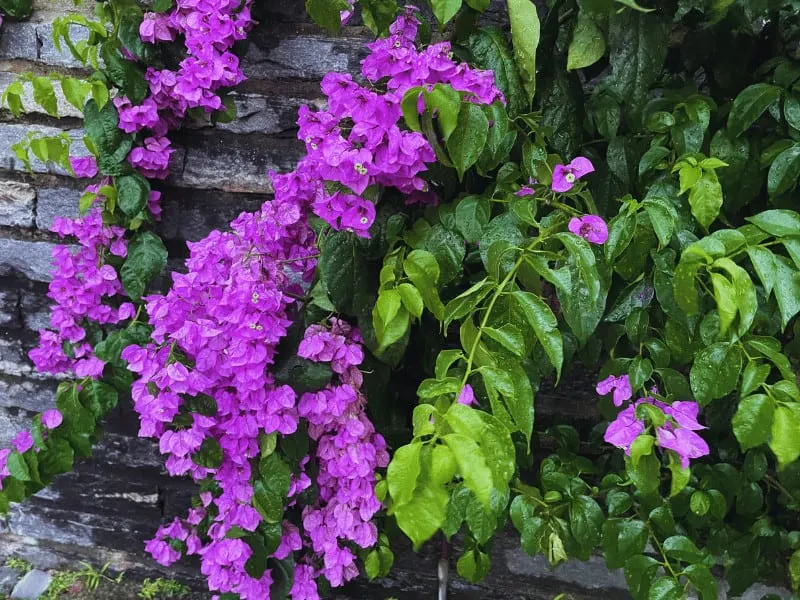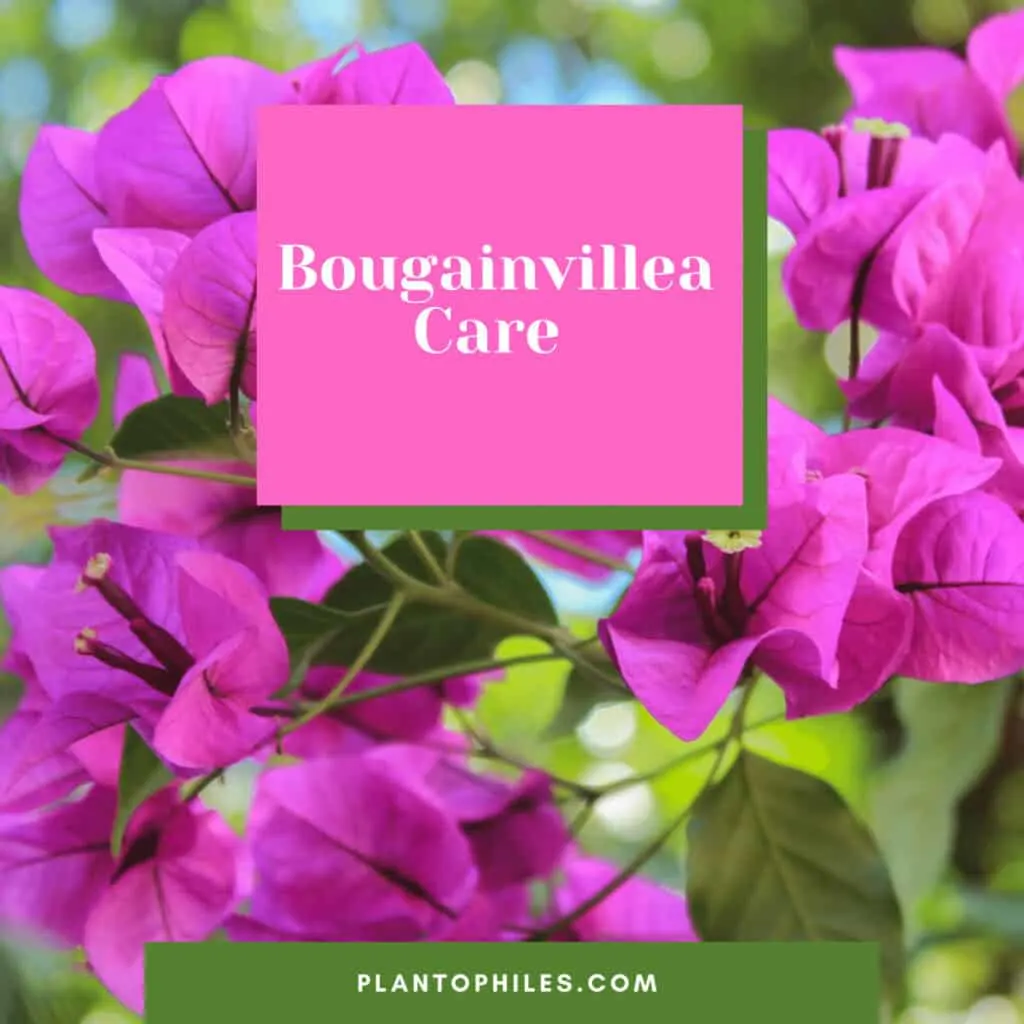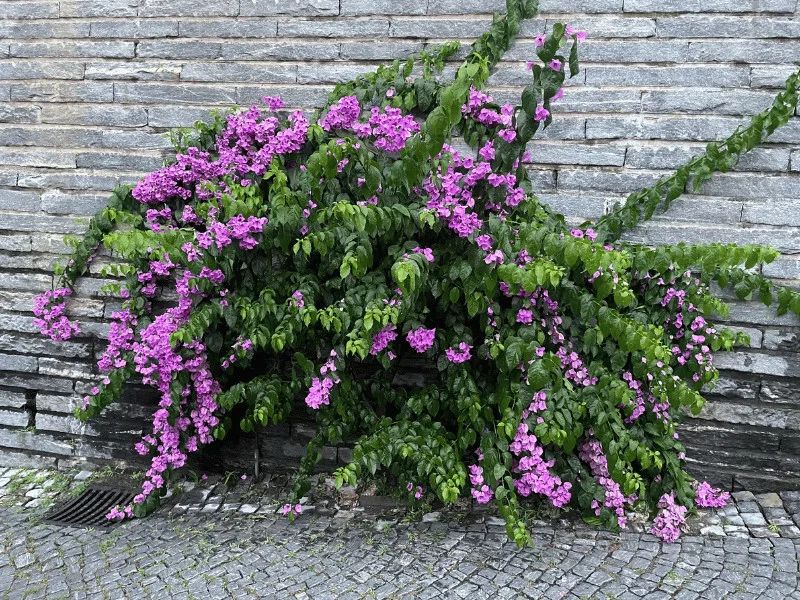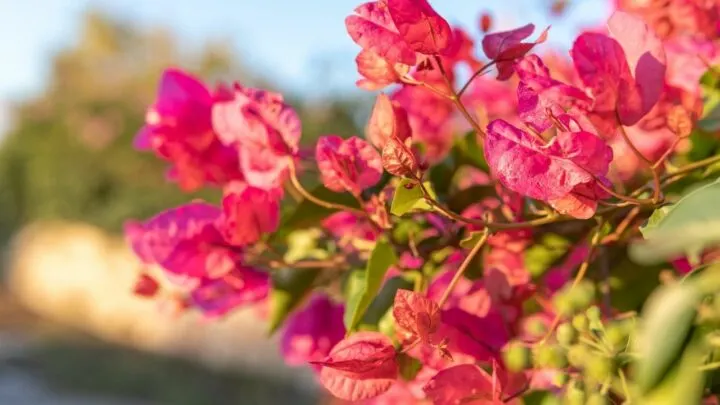You are reading this article to learn more about the Bougainvillea plant and its care.
Bougainvillea Plant
Bougainvillea or Bougainvillea glabra var. brachycarpa using its scientific name, is a thorny vining plant with showy flowers that is easy plants to grow. It flowers for most of the year and delivers a spectacular display.
It is hardy and resistant to drought and most pests and diseases. It is a low-maintenance plant that gives you many options.

Table of Contents
Bougainvillea Takeaways
| Species | Bougainvillea |
| Synonyms | Paper flower |
| Family | Nyctaginaceae |
| Genus | Bougainvillea |
| Propogation | Stem cuttings, air layering |
| Growth | Bushy, vining plant, tree, bush |
| Height | 30 feet |
| Soil | Well-drained soil that is slightly acidic |
| Watering | Water every 21 to 28 days |
| Light | Full sunlight |
| Temperature | 60 to 80°F |
| Humidity | 50-70% |
| Fertilizer | Fertilize every 2 months |
| Propagation | Stem cuttings, air layering |
| Toxicity | Mildly toxic to animals such as cats and dogs and humans if ingested. Thorns can lead to dermatitis and rashes. |
Bougainvillea Care
To care for Bougainvillea provide full sun. The ideal soil is well-draining and nutrient-rich. The ideal temperature is between 60-80°F. (16-27°C). Keep the humidity between 50-70%. Water every 3-4 weeks. Fertilize every two months in spring and summer using an all-purpose fertilizer.

Soil
Bougainvillea likes well-drained soil that is slightly acidic. The ideal pH is 5.5 to 6. Good quality soil that is nutrient-rich will reduce the need to add much in the way of fertilizer.
Light
The best position for a Bougainvillea is somewhere with full sunlight, although it can handle dappled shade, provided there is some decent sunlight.

Watering
Water the Bougainvillea plant every 3-4 weeks.
The Bougainvillea will prefer soil that is slightly drier than the average plant in the garden.
A newly planted bougainvillea will need quite a bit of water until it is established and settled. After that, less water is needed.
Ensure the soil drains well and you do not over-water the plant.
If planted in a pot, you want to give it more water but not too much. Again, make sure the pot you’ll use has good drainage.
Pots and containers dry out quickly, so you should water them every two to three days. Try to water less when the plant is blooming to get more flowers.
Temperature
The ideal temperature is 60-80°F. (16-27°C). Bougainvillea is best suited to a temperate climate. The temperature should stay above 60 degrees Fahrenheit (16 degrees Celsius). Although very hardy, it does not like frost.
If you live in an area with regular frost, planting your bougainvillea in a pot is probably better. This will allow you to bring them in on very cold nights.
One can also use a frost cover or cloth to protect plants outdoors. Often, the plant might be damaged by frost yet still survive. Once the frost is over, cut back the dead growth, and it will probably grow back.
Humidity is not a major issue, but you do not want excess moisture to accumulate and remain on the plant as this can lead to problems.
Humidity
This plant prefers a humidity between 50-70% as it is native to South America.
Where to plant Bougainvilleas
The bougainvillea does best in full sun. It can handle a bit of shade so long as it gets a good few hours of sun most days. They grow quickly and can get rather large, so the position and spacing are important.
How to plant a Bougainvillea
Bougainvilleas can be grown in the ground or in a pot or other planting container. The best time to plant or pot a bougainvillea is spring or summer.
But they are quite hardy, and with the right care, you can do it throughout the year.
Planting in the ground
Taking care to find a warm sunny spot with good soil and decent drainage, you would plant the bougainvillea in much the same way as any other shrub.
Remove the plant from its current container and loosen any compacted soil surrounding the rootball.
Prepare a hole twice as wide as its rootball, with the loose soil at the bottom. The loose soil beneath where you plant will help the soil to drain, which is what you need.
If the soil is not in great condition you can make it a bit deeper and add some organic compost to enrich it.
It will need to be well watered for the first few weeks as it settles and establishes itself.
As with all planting, you want the new soil level to be the same as the medium the plant was growing in before. Do not planter deeper or more shallow than how it grew before.
Planting in containers
Ensure the container or pot has good drainage holes. You can even add a small number of pebbles to the base of the container to help ensure good drainage.
Use quality potting mix, organic is always the best way to go. Again, you can mix in compost. Work on a ratio of roughly 1 part compost to 4 parts potting soil.
Water frequently at first and then still water two to three times per week as pots can dry out quickly. You will have to water more in the hot months.
Here are a few varieties that do well in containers and their colors. You can grow any bougainvillea in a pot, but the shorter-growing ones are easier to manage.
Here are a few popular choices:
- Vera Deep Purple – Purple
- Singapore Pink – Pink
- Rosenka -Pink
- Crimson Jewel – Red
- La Jolla -Red
- Raspberry Ice – Magenta
- Oo-La-La – Magneta
- Miss Alice – White
- Bambino Baby Sophia – Orange
Bougainvillea Fertilizer
Fertilize every two months in spring and summer using an all-purpose fertilizer.
The bougainvillea is a hardy plant. It will, however, improve the richness and vibrancy of the blooms and ensure healthy growth if fertilized.
The best time to fertilize is the beginning of spring through to the middle of summer. Organic slow-release fertilizer is a good option.
Remember that the bougainvillea likes low pH (slightly acidic) soil. A Hibiscus or other fertilizer designed specifically for acid-loving plants will always help.
Fertilize sparingly. Overfertilizing will result in many shoots or new growth but fewer flowers.
Growth
They can get quite large and grow from 2 to 3 feet up to 30 feet plus, depending on the age, the variety, and where they are planted. The bottom line is that a happy bougainvillea can get big, very big.
The bougainvillea is a highly versatile plant that is easy to grow in the garden or in a pot and rewards you with a delightful profusion of color in spring right through summer and autumn.
It is easy to grow, does not need much care, and blooms well.
The bougainvillea comes in various colors and flower sizes, so there is something to suit all gardens and garden styles and tastes. They are fast-growing and add instant interest to your garden.
The Bougainvillea plant
Before we get into the specifics, let’s look at this popular plant.
The bougainvillea is a fast-growing vine that can be trained to grow on a trellis or other structure or simply grow as a stand-alone plant.
They are native to Central America, many parts of South America, Spain, and the Caribbean Islands.
The bougainvillea is hardy and likes full sun. The most common bougainvillea colors are purple, dark pink, and a deep rich red.
They also come in white, white with pink edges, orange, yellow, and pale pink. What we normally refer to as flowers are, in fact, bracts. These are leaves.
The plant prefers a warm climate, but with some effort, you can grow them in moderately colder regions.
In cold areas, they are best grown in pots where they can be taken indoors or undercover when it gets very cold.
Besides their hardiness and spectacular color displays, the bougainvillea will attract butterflies and birds, including the hummingbird, to your garden.
Continue reading below to learn more about growing the beautiful bougainvillea.
Pruning the Bougainvillea
There are various reasons why to trim a bougainvillea. The main one is that, if left untamed, it can grow quite wild. It could creep on windows or downpipes, even the roof.
It might become too heavy for the trellis or supporting structure.
If any branch is damaged, it should be cut back. Cut at a joint on the branch and prune at an angle. This will allow water to drain off the cut so as not to allow it to build up and cause rot or other issues.
Although the bougainvillea is an evergreen plant, you might want to prune them back into shape at the end of the flowering season. They are fast and vigorous growers, when happy, and can get out of shape.
When grown in pots, as climbers, or simply in the garden, it is a good idea to prune them once a year to keep a tidy shape that does not take over the area.
If they start to look scraggly or untidy, you can do this more often.
Bougainvillea can also be grown into standards or other shapes, These will need to be pruned more regularly to retain their shape.
Be careful of the thorns when pruning. Managing an overgrown bougainvillea is not a task for the timid. Use gloves and protective clothing.
The new bracts (flowers) will come from new growth, so careful pruning is not only important for the plant’s shape but also to ensure a flourish of new blooms when the months get warmer.
You can also make a bonsai from the bougainvillea. It is spectacular once you have it right, and it does not take too long. Specialist knowledge, skills, and patience are required.
How to Train a Bougainvillea
One of the many benefits of this plant is that it will take any shape or form you want. It is a vine, so it will happily grow along with a pergola, trellis, or other structure.
It can also function as a stand-alone plant, although you must keep it in shape.
Plant ties or stockings will help to support the plant and lead it in the right direction. Correct pruning will keep it in shape and prevent it from getting too large or heavy.
Bougainvillea Propagation
These plants can be propagated through water stem cuttings or air layering.
Cuttings in water
One way to propagate the bougainvillea is from a stem-cutting set into the water. You can use hardwood cuttings in the cooler months or softwood cuttings in the warmer seasons.
Take care not to cause damage to the roots when planting the cuttings.
Some people slowly add soil to the water mixture over a few days or weeks. This will prevent any damage or shock to the roots.
Stem cuttings
The best time to take cuttings is mid-spring or towards the end or just after flowering.
You want to select healthy stems that are semi-hard. They should have good leaf growth and be around 6 inches long.
Always ensure your tools are sharp, clean, and sterilized.
Prepare the pots with a mixture of potting soil and perlite in equal quantities. The container should be roughly 4 inches and have good drainage. Moisten the soil before cutting the stems.
Take the cuttings in the morning for the best results. Look for stems without blooms or pinch them off if there are.
Cut just before a set of leaves at an angle of 45 degrees. Be wary of the thorns, and use gloves when making your cuts.
Dip the tip into the rooting hormone, ensuring it is well coated. Dip into the prepared pots, firm the soil down gently, and cover with a plastic bag.
Place the pots out of direct midday sun but with plenty of warmth and filtered light.
The ideal temperature for successful propagation is around 75 degrees Fahrenheit or more.
It will take a month or two for roots to develop. Only water if the condensation from the bag is absent.
It is safest to allow the plant to fully establish itself and develop a good root system. This could take up to a year.
After that, you can plant the bougainvillea out into the ground in a sunny position. Follow the tips on replanting above.
Layering
This is one of the easiest ways to propagate a bougainvillea.
Select branches close to the ground. Use a knife to remove a small section of bark, scrape it off.
Push the cut side down into the soil and use something to keep it is lace and weigh it down.
This process is called layering.
It will take several weeks to months for roots to develop. Be patient.
Gently lift the layered section after a few weeks to check. Rather wait until the roots are well established.
You can then cut the rooted section away from the main plant, remove it from the soil, and place it where needed.
Bougainvillea Pests
Caterpillars
Several caterpillars like to feast on the bougainvillea. If left alone, they could soon destroy a beautiful plant. They are often tricky to see and are normally active at night or early morning.
They range in color from brown to green and size from around one inch to 3 inches. The color and size make them even more difficult to spot and identify.
The Disclisioprocta stellate or Bougainvillea Looper is the most common caterpillar that preys on the bougainvillea.
One way to combat this problem is to hand remove them in the evenings when they are active. Although tricky to find, you should be able to spot most of them with a flashlight.
The best solution is to use Neem or Neem Oil. You can get this easily and it is organic and safe.
You need to spray in the evening or early in the day. Mix it as per directions on the bottle and spray the plant liberally.
Keep an eye on the plant; you may need to reapply every week until the problem is controlled.
Oils work better in the cooler seasons and are less effective when hot. The oil runs off the plant.
In the hot season, it would be better to use insecticidal soap. Although it needs to be applied after every rain, it is a better idea when the temperature is high.
Another option is to use an insecticide spray. Go for something that contains spinosad.
This is particularly effective against the looper. One needs to spray the entire plant and reapply as necessary.
Aphids
This is a relatively common issue in some climates. Most gardeners will recognize these small soft insects that appear on many plants.
A healthy plant will not be too distressed by aphids, but you could have a problem if they multiply vigorously.
The most common aphid on the bougainvillea is green, although they also come in black, red, yellow, white, and brown.
If the plant is infested, the leaves could turn yellow and curl, and you might notice the honeydew that the insect secretes. This generally turns black as mold accumulates on the secretion.
It is normally spread by other infected plants, so you must watch the entire garden.
You can use neem oil or insecticidal soap to treat the plants if aphids occur. Remove badly infested branches and dispose of them.
Leaf Miner
If you notice small tunnels developing in the leaves, this could result from leaf miners. These guys produce larva that starts to eat the leaf from the inside as soon as they emerge. The adults do no harm or damage.
They love the newly sprouted tender leaves. A large infestation will leave your bougainvillea looking damaged and unhappy. Leaves will change shape, lose color and curl up.
Pheromone traps are the best method to prevent and control this problem. You will need to replace them from time to time.
Follow the instructions that they come with and position them at roughly shoulder height for best results.
Scale
These tough insects are small and have strong outer shells. There are a few varieties of scale some being slightly larger. Mealybugs are also classified as scale and can be a menace.
This insect attacks the inside of the plant which conducts fluid up the stem. If you have a serious infestation you will notice that leaves start to brown or yellow. They may also drop.
Leave might curl and bracts could be disturbed and irregular.
This is not a common problem with this plant and can be treated with specific oils and organic solutions.
Thrips
Thrips also suck the contents of the plant cells and, if left to multiply, could cause problems and damage to the plant. They tend to feed mainly on new growth, leaving evidence of feeding on the leaves.
They have many natural predators, so are normally not a major threat. Again, oils will help if you do have a major issue.
Spider Mites
The bougainvillea is not immune to spider mites and, under certain conditions, could become infested. They are small but, in large numbers, are normally quite easy to sport.
They will appear on the leaf’s underside.
Again, they are sucking insects that draw liquid and nutrients from the plant. They are only a concern in large numbers.
Snails and slugs
The common garden pest, the snail, will occasionally prey on the bougainvillea. They thrive in debris and vegetative matter on the ground.
Correct garden maintenance will reduce the risk. They are quite easy to remove and eliminate manually.
Bougainvillea Diseases
Root rot
An established bougainvillea does not like to have wet feet. In other words, it needs well-draining soil and not too much water.
Ensure good drainage and prevent the area from being overwatered or becoming soggy.
Once root rot has set in, treating it can be quite challenging. Prevention is indeed the best cure for this problem.
Powdery mildew
This is not a common problem but can occur. One needs to use a fungicide spray to treat this problem.
There are several options, including organic sprays. Remove any branches that are infected and dispose of them. Please do not add them to the compost heap.
Rust
A fungus causes this and can occur if there is not enough sunlight and is encouraged by high temperatures and humidity.
It can be treated with a general fungicide. Again, remove damaged parts of the plant and dispose of them.
Leaf Spot – Fungal and Bacterial
Too much moisture on the leaves could result in leaf spot development. Growth will be affected and distorted, lesions on the leaf might be noted, and eventually, the edges of the leaf will become dry and wrinkled.
The best control is to prevent the accumulation of moisture for extended periods. This is done by pruning away larger leaves or growth surrounding the plant. Cut back any infected branches. You want to ensure the plant gets decent airflow and light.
For severe infections, one can use a chemical spray.
Remember that pests and diseases attack weak, unhealthy plants. The best solution is always prevention.
If you keep your plant happy and healthy and practice basic garden maintenance and care, you should have little to no problems with your bougainvillea.
They are tough and resilient. Provided they are happy in their environment, you are unlikely to have major problems with pests or diseases.
Bougainvillea problems
Frost damage
The bougainvillea does not like frost. Some people grow it as an annual in frosty areas so do not be surprised when it dies back or dies completely.
This is a costly and time-consuming exercise and best for ardent bougainvillea fans only.
You can cover the plant with frost cloth to protect it from the coldest periods. Do not use hard plastic, as this could make the problem worse.
Frost cloth is protective but still breathable. Remove the frost covers when it warms, or the sun comes out.
When a wall or other structure protects the plant on at least one side, it is often hardier and can handle colder snaps.
Often the plant does not die completely, and one needs to prune back the damaged areas once the frost is over. It could well surprise you as soon as the temperature rises again.
Nutrient deficiency
While the bougainvillea is a hardy plant that does not require much in the way of pampering, in poor soil or bad conditions, it could experience a lack of nutrients.
Chlorosis is the worst of these and is caused but a lack of magnesium and iron. Yellowing leaves are one of the symptoms.
Note that the plant prefers slightly acidic soil. Use a slow-release organic fertilizer to prevent or treat this issue.
Another cost-effective treatment is to dilute Epsom salts into your water.
Frequently Asked Questions
How do I grow Bougainvillea if I live in an area with frost?
The best and easiest way to do this is to plant them in a pot. You can take them indoors or under shelter if temperatures drop too low. The other option to cover the plant is frost cloth. This takes time and effort. If the temperature rises, the frost cloth should not be left on during the day.
Will frost kill my Bougainvillea?
It depends on how low the temperature drops and how long it will last. Most of these plants can bounce back after a spell of frost. Wait until the frost is over and cut away the dead branches.
When do Bougainvillea flower?
Bougainvillea put on a great display for most of the year. The only time they are unlikely to bloom is in the dead of winter. They do well from spring to autumn, generally from April to December, depending on the local climate.
How do I know when to water my potted Bougainvillea?
Bougainvillea does not like too much water and does not like to have their feet wet. Try to let the soil dry between watering. If you feel the top two inches of soil are dry, you can water it well with your fingers.
Can I grow my Bougainvillea in a hanging basket?
Bougainvillea can be grown in hanging baskets. Go for a large basket and select one of the shorter-growing varieties.
I hope my Bougainvillea plant care tips are helpful!

Daniel has been a plant enthusiast for over 20 years. He owns hundreds of houseplants and prepares for the chili growing seasons yearly with great anticipation. His favorite plants are plant species in the Araceae family, such as Monstera, Philodendron, and Anthurium. He also loves gardening and is growing hot peppers, tomatoes, and many more vegetables.


